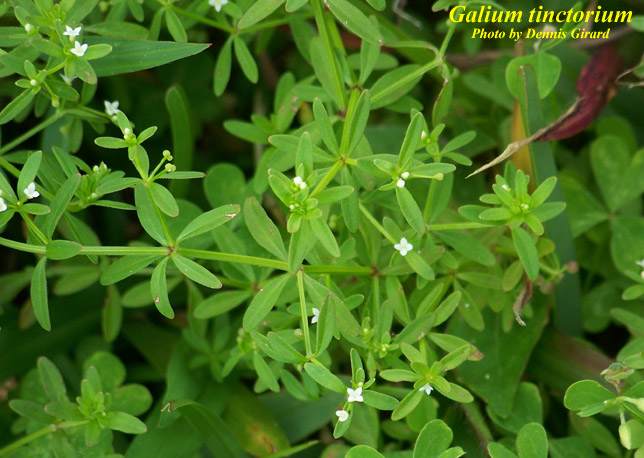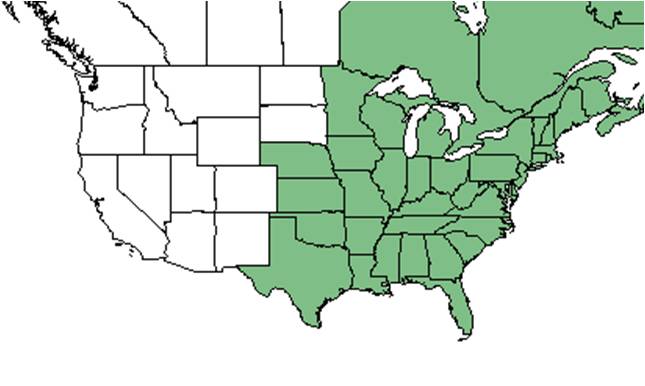Galium tinctorium
| Galium tinctorium | |
|---|---|

| |
| Photo by Dennis Girard, Atlas of Florida Vascular Plants | |
| Scientific classification | |
| Kingdom: | Plantae |
| Division: | Magnoliophyta - Flowering plants |
| Class: | Magnoliopsida - Dicotyledons |
| Order: | Rubiales |
| Family: | Rubiaceae |
| Genus: | Galium |
| Species: | G. tinctorium |
| Binomial name | |
| Galium tinctorium (L.) Scop. | |

| |
| Natural range of Galium tinctorium from USDA NRCS Plants Database. | |
Common name: Stiff marsh bedstraw
Contents
Taxonomic notes
Synonyms: Galium obtusum var. floridanum (Wiegand) Fernald; G. claytonii Michaux; G. tinctorium ssp. floridanum (Wiegand) Puff
Description
A perennial plant with 5-6 whorled dark green leaves per node along the stem.[1] Roots are fibrous and rhizomatous. Flowers are radially symmetrical and are in clusters of three arising from leaf axiles and at the end of branching stems.[2]
Generally, Galium genus are "perennial or annual herbs, the stems weak, often scabrous; the roots often red or orange. Leaves whorled, entire. Flowers in simple or profusely branched cymes or the inflorescence reduced and the flowers 1-several and axillary; sepals usually obsolete, corolla rotate, 3-5 lobed; stamens 3-5. Fruit dry or sometimes fleshy, indehiscent, subglobose or reniform, or if the two carpels both develop and stay together the fruit broader than long."[3]
Specifically, for this species, G. tinctorium is an "annual (?), stems lax, spreading or reclining, simple or weakly branched, 2-5 dm long, minutely scaberulous, glabrous. Leaves usually 5-6 per node, rarely 4, linear to narrowly oblanceolate, 5-12 mm long, 1-2 mm wide or rarely more, rounded, glabrous. Corolla 3-lobed, white. Fruit dry, black, smooth subglobose, ca. 1.5 mm in diam. "[3]
Distribution
Ecology
Habitat
In the Coastal Plain in Florida and Georgia, G. tinctorium has been found in cabbage palm hammocks, boggy depressions in coastal hammocks, bordering lakes, wet pine flatwoods, cypress swamps, river banks, Nyssa bottomlands, longleaf pine/saw palmetto flatwoods, sweetbay swamps, and bordering salt marshes. It can also occur in human disturbed areas such as roadside ditches, gas pipeline corridors, shores of drainage canals, and roadside seepage zones. [4] Soil types include sandy loam, loamy clay, and clayey sand.[4] Associated species include Lilaeopsis carolinensis, Typha latifolia, Hydrocotyle umbellata, Fraxinus, Liquidambar, Acer, Gleditsia, Nyssa, Ulmus, and Carpinus.[4]
Phenology
G. tinctorium has been observed to flower March through June and fruit April through August.[5][4] Flowers are hermaphroditic.[6] Fruits are a pair of tiny, smooth round pods, each containing a seed.[2]
Pollination
The following Hymenoptera families and species were observed visiting flowers of Galium tinctorium at Archbold Biological Station:[7]
Vespidae: Leptochilus alcolhuus
Conservation and management
Cultivation and restoration
Photo Gallery
References and notes
- ↑ [Go Botany]Accessed: December 11, 2015
- ↑ 2.0 2.1 [[1]]Accessed: December 11, 2015
- ↑ 3.0 3.1 Radford, Albert E., Harry E. Ahles, and C. Ritchie Bell. Manual of the Vascular Flora of the Carolinas. 1964, 1968. The University of North Carolina Press. 984-7. Print.
- ↑ 4.0 4.1 4.2 4.3 Florida State University Robert K. Godfrey Herbarium database. URL: http://herbarium.bio.fsu.edu. Last accessed: October 2015. Collectors: : Loran C. Anderson, George R. Cooley, M.W. Cullen,R. J. Eaton, J.P. Gillespie, R.K. Godfrey, Richard D. Houk, J.M. Kane, R. Kral, R.B. Ledin, Robert J. Lemaire, S.W. Leonard, William Lindsey, Sidney McDaniel, R.C. Phillips, James D. Ray, P.L. Redfearn , Grady Reinert, Paul O. Schallert, Cecil R. Slaughter, John K. Small, E. Smith, J.N. Triplett Jr., C.E. Wood. States and Counties: Florida: Alachua, Brevard, Citrus, Clay, Collier, Columbia, DeSoto, Flagler, Franklin, Gadsden, Gulf, Hamilton, Highland, Hillsborough, Holmes, Indian River, Jefferson, Leon, Levy, Liberty, Marion, Martin, Nassau, Orange, Polk, Putnam, Santa Rosa, Seminole, St. Johns, Union, Wakulla, Washington. Georgia: Thomas. Compiled by Tall Timbers Research Station and Land Conservancy.
- ↑ Nelson, G. PanFlora: Plant data for the eastern United States with emphasis on the Southeastern Coastal Plains, Florida, and the Florida Panhandle. www.gilnelson.com/PanFlora/ Accessed: 9 DEC 2016
- ↑ [[2]] Accessed: December 11, 2015
- ↑ Deyrup, M.A. and N.D. 2015. Database of observations of Hymenoptera visitations to flowers of plants on Archbold Biological Station, Florida, USA.